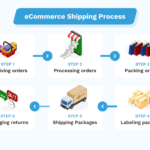
In today’s rapidly evolving digital sphere, there’s a subtle yet profound transformation underway in the realm of eCommerce: the rise of voice commerce. As consumers increasingly prioritize convenience and efficiency in their shopping journeys, this innovative approach has swiftly gained traction, revolutionizing how people explore, select, and purchase products online.
But voice commerce isn’t just about convenience; it represents a significant step forward in making eCommerce more accessible. Many individuals, particularly those with visual impairments or physical disabilities, encounter substantial barriers when navigating traditional online shopping platforms. However, with its hands-free navigation and transaction capabilities, voice commerce offers a solution to these challenges, significantly expanding the reach and inclusivity of eCommerce.
In this article, we’ll explore the realm of voice commerce optimization, exploring its burgeoning role within eCommerce and its intersection with accessibility. We’ll examine how embracing this technology can foster a more inclusive shopping environment and discuss the implications for both businesses and consumers. Additionally, we’ll provide practical insights into optimizing your eCommerce store for voice search, enhancing its accessibility, and improving the overall user experience.
Read More: AMAZON SELLER CONSULTING SERVICES: TYPES OF CONSULTING SERVICES!
OZ FBA Prep Services is one of the best FBA Prep and Fulfillment Services that provides the support you need to grow your business by accurately and efficiently prepping your products.
| SERVICE | DESCRIPTION | LEARN MORE |
|---|---|---|
| WHOLESALE SERVICES | WE SOURCE PRODUCTS DIRECTLY FROM BRAND DISTRIBUTORS AND SUPPLIERS. | LEARN MORE |
| WAREHOUSING | YOUR INVENTORY IS STORED IN OUR WAREHOUSE, AND WE PROVIDE TOP-NOTCH SHIPPING SERVICES WITHIN AUSTRALIA. | LEARN MORE |
| INSPECTION AND RE-BOXING | UPON RECEIVING YOUR INVENTORY, WE CONDUCT THOROUGH INSPECTIONS FOR QUANTITY AND QUALITY. WE CAN PROVIDE PICTURES, VIDEOS, AND REPORTS UPON REQUEST FOR AN ADDITIONAL FEE. | LEARN MORE |
Exploring Voice Commerce:
Voice commerce is a rapidly growing aspect of eCommerce, leveraging voice commands through smart devices and virtual assistants such as Siri, Google Assistant, and Alexa to facilitate online shopping. With voice commands, consumers can perform various actions like product searches, price comparisons, adding items to their cart, and completing purchases. Voice commerce primarily consists of two main components:
- Voice Shopping: This involves customers using voice commands to search for and buy products online. For instance, they might instruct their virtual assistant to “Buy a new iPhone charger,” prompting the assistant to find a suitable charger, add it to the cart, and finalize the purchase on behalf of the user.
- Voice Payments: Users can manage and pay bills through voice commands. For example, they could tell their virtual assistant to “Pay the electricity bill,” and the assistant would handle the payment process using the stored payment information.
Voice commerce serves as a vital tool in enhancing eCommerce accessibility. Traditional online shopping methods can pose significant challenges for individuals with physical disabilities, limited mobility, or visual impairments. Voice commerce enables these individuals to shop independently, ensuring a smoother and more inclusive online shopping experience and thereby expanding business outreach.
Strategies for Optimizing Voice Commerce Experiences:
- Personalized Recommendations: Utilize user data and machine learning algorithms to offer personalized product recommendations based on individual preferences and past purchases. Tailoring the voice commerce experience to each user enhances customer satisfaction and drives sales.
- Seamless Integration: Ensure smooth integration between voice assistants and e-commerce platforms. Optimize voice recognition technology to accurately understand user commands and provide relevant responses. Streamlining the user experience facilitates smooth transactions and boosts customer engagement.
- Voice Search Optimization: With the proliferation of voice assistants, optimizing e-commerce websites for voice search is crucial. Incorporate natural language processing techniques to understand user queries and deliver accurate search results. Optimize product descriptions and metadata for voice search to improve discoverability and attract more customers.
- Voice-Enabled Customer Support: Integrate voice assistants into customer support channels to enhance the overall voice commerce experience. Enable customers to interact with a voice assistant for inquiries, troubleshooting, and order tracking, providing real-time assistance and boosting customer satisfaction.
- Voice-Activated Promotions: Leverage voice-activated promotions to drive sales. Offer exclusive discounts or limited-time offers that can be activated through voice commands, creating a sense of urgency and encouraging impulse purchases.
These strategies aim to optimize voice commerce experiences by incorporating personalized recommendations, seamless integration, voice search optimization, voice-enabled customer support, and voice-activated promotions. Implementing these strategies enables entrepreneurs to capitalize on the growing trend of voice commerce and provide a seamless and engaging shopping experience for their customers.
Understanding Legal and Ethical Implications:
Before delving into voice commerce, it’s essential to consider the legal and ethical aspects involved. Several regulations govern accessibility in eCommerce, and businesses must ensure compliance:
- Americans with Disabilities Act (ADA): This law in the United States aims to prevent discrimination against individuals with disabilities. While not explicitly mentioning voice commerce, it emphasizes accessible digital services.
- Rehabilitation Act Section 508: Federal agencies must make their electronic and information technology accessible to people with disabilities, a standard often adopted by private businesses.
- General Data Protection Regulation (GDPR): In Europe, GDPR affects voice commerce, especially concerning the storage and use of voice data, requiring businesses to protect user data adequately.
From an ethical standpoint, companies should prioritize inclusivity, ensuring their services are accessible to all users.
Benefits of Embracing Voice Search in eCommerce:
Aside from meeting legal and ethical obligations, incorporating voice commerce and improving accessibility offers numerous advantages:
- Enhanced User Experience: Voice search provides a faster and more convenient shopping experience, especially for those with visual impairments or physical limitations.
- Improved SEO and Expanded Reach: By optimizing for voice search, businesses can boost search rankings and reach a broader audience, including tech-savvy users and those relying on voice commands for accessibility.
- Reduced Legal Risks: Optimizing eCommerce for voice search ensures compliance with accessibility standards, minimizing the risk of legal liabilities.
How to Optimize Your eCommerce Store for Voice Search:
As businesses embrace voice commerce, adapting to this trend becomes essential. Here are practical steps to optimize your eCommerce store for voice search:
- Incorporate Text-to-Speech Software: Implement text-to-speech technology on your website to convert written text into spoken words. This allows users to listen to product descriptions and other essential information, benefiting those with visual impairments or literacy challenges.
- Develop a Voice-Friendly Website Layout: Design your website with voice search users in mind. Organize content logically, use effective heading tags, and ensure all interactive elements are compatible with voice commands for easy navigation.
- Ensure Keyboard Accessibility: Make your eCommerce site accessible via keyboard navigation, benefiting users who rely on keyboard-only navigation or voice recognition software. Ensure all functions can be performed using a keyboard, with clear visual focus indicators.
- Provide Clear Instructions for Voice Search Users: Not all users may be familiar with voice search, so offer clear, simple instructions to assist them. Provide guidance on how to use voice search on your site or offer verbal prompts for voice commands to enhance the shopping experience.
Optimizing your eCommerce store for voice search involves leveraging new technologies, restructuring your site, and providing support for users. The result is an inclusive and user-friendly platform that caters to the diverse needs of consumers, encouraging continued engagement and loyalty.





